Studies on the Equatorial Spot of G-type Contact Binary UV Lyn
Jing-Jing Wang ,Bin Zhang,and Lin-Qiao Jiang
1 China University of Petroleum–Beijing at Karamay,Anding Road 355,834000 Karamay,China;wangjingjing@cupk.edu.cn
2 School of Physics and Electronic Science,Guizhou Normal University,550025 Guiyang,China
3 School of Physics and Electronic Engineering,Sichuan University of Science Engineering,643000 Zigong,China
Received 2021 August 28;revised 2021 October 28;accepted 2021 November 16;published 2022 February 2
Abstract New CCD photometric observations of G-type contact binary UV Lyn were obtained in 2006 and 2020,when the light curves(LCs)showed positive O’Connell effect and negative O’Connell effect,respectively.From the previous studies,the LCs by other ground-based telescope are variable from 1973 to 2020,particularly the magnitude difference between the two maxima.These phenomena indicate that the component has been active in the past 47 yr.In addition,during monitoring by the space telescope Transiting Exoplanet Survey Satellite(TESS)from January to March 2020,we fortunately found continuous variations from the O’Connell effect in every cycle for the first time.The analysis also shows that in a short time,the positive O’Connell effect has been transformed into the negative one,which demonstrates that there are stronger magnetic activities on the surface of the component.By using the Wilson-Devinney code with a spot model,these photometric solutions con firm UV Lyn is a shallow W-subtype contact binary with a cool equatorial spot on the less massive component.The successive variability of the O’Connell effect possibly results from one equatorial cool spot shifting gradually along with time.We also investigated its O-C curve from these continuous LCs,and there is no apparent variation in such a short time.However,regarding the O’Connell effect as the indicator of magnetic activity indicates the system is possibly undergoing a periodic trend with a period of nearly 38 days.Comparing with the trend of the O-C curve,we could not find any relation between the period variation and magnetic activity.
Key words:(stars:)binaries(including multiple):close–stars:solar-type–stars:magnetic field
1.Introduction
Due to forced synchronous rotation,the late-type components of WUMa binaries should have extremely rapid rotation,where magnetic activities like the spots and chromospheric and coronal emissions are possibly stronger.The distortions and variations of the light curves(hereafter LCs)are regarded as direct evidence of these activities on the stellar photospheres of at least one component.In recent years,the LCs of some G-type contact binaries,such as:V524 Mon(He et al.2012),EQ Tau(Li et al.2014;Hasanzadeh et al.2015),FG Hya(Qian&Yang 2005;Zhang et al.2017),GN Boo(Wang et al.2014)and V1005 Her(Zhu et al.2019),are variable on the timescale of a few days,months or years.Moreover,the unbroken timeseries photometry is expected to play an important role in studies on their activity.Based on the successive LCs of W UMa contact binaries,some properties of magnetic activities were revealed.As monitored by the Kepler Space Telescope from 2009 to 2013,the stable LCs indicate that both components of the solar-like contact binary V2284 Cyg are inactive(Wang et al.2017).By analyzing the nearly unbroken photometric data from the Chinese Small Telescope ARray in Antarctica during 2008,the asymmetric LCs were interpreted as the presence of a dark spot with a lifetime close to 116 days(Qian et al.2014).The asymmetric height between light maxima(hereafter the O’Connell effect)is still considered as important observational evidence for magnetic activities of solar-like binaries(Li et al.2014;Qian et al.2014;He et al.2016).With the development of space telescopes,we have a good chance to understand how the O’Connell effect changes with time.
UV Lyn was first discovered as an eclipsing binary by Geyer et al.(1955).After Kuklin(1961)published several times of minima,Strohmeier et al.(1964)found that it is EW-type with a period of 1.147 days.Bossen(1973)suggested that it could be a detached or semidetached binary system with a period of 0.41497872 days,and unequal heights of maximum light were observed first.Markworth&Michaels(1982)calculated that it is an over-contact binary with mass ratio ofq=0.526(5)from the completeUBV-band LCs without O’Connell effect in 1981.Later,Zhang et al.(1995)presentedBV-band LCs in 1994,in which Max I is brighter than Max II by about 0.03 mag inVand 0.05 mag inB,the asymmetries of which could be caused by a gaseous stream between the components.They also found the period is increasing distinctly but slowly.The spectroscopic orbital parameters determined by Lu& Rucinski(1999)indicated that the system is a W-subtype contact binary.Vanko et al.(2001)reported that their asymmetricBV-band LCs in 2001 are due to the dark spot on the equator.From research on their asymmetricBV-band observations(Kjurkchieva et al.2020),UV Lyn is a W-subtype shallow-contact binary with the presence of a stable cool spot during several decades.The sinusoidal shape with a period of 24 yr in theirO-Cdiagram could be attributed to the light-travel time effect of a third body.Meanwhile,Lu et al.(2020)collected 244 times of light minimum to investigateO-Cagain,which presented an increasing period that is explained as mass transfer from the less massive component to the more massive component.They also pointed out the longitudes of cool starspot are mainly concentrated in the range of 230°~40°.
From above,the variable O’Connell effect observed by Lu et al.(2020),Kjurkchieva et al.(2020),Vanko et al.(2001),Zhang et al.(1995),Bossen(1973)suggest the presence of magnetic activities during several decades.In order to understand the magnetic activity of G-type contact binary UV Lyn,we also monitor it and look for continuous observations from the space telescope Transiting Exoplanet Survey Satellite(TESS),and the associated detailed studies on magnetic activities and evolution are discussed in this paper.
2.Investigations on LCs from the Ground-based Telescope
2.1.Observations
New photometric observations of UV Lyn were obtained in theBRcbands with the DW436 2048×2048 CCD photometric system,which was installed on the 60 cm re flecting telescope administered by Yunnan Observatories,for two nights on January 29 and 31 in 2006.The effective field of the photometric system was 12′ × 12′ at Cassegrain focus.Theintegration time of theBRcbands was 100 s.We carried out the four-color photometric observations in two nights on March 16 and 17 in 2020,with the DZ936N 2048×2048 CCD camera attached to the 60 cm telescope at Xinglong Station of National Astronomical Observatories of the Chinese Academy of Sciences.The effective f ield of view was 13.′5 × 13′.5.The integration times were 30 s forBband,20 s forVband,10 s forRcband and 8 s forIcband.The mean photometric errors for individual observations are less than 0.002 mag.Based on the observations,we derived four times of light minimum and listed them in Table 1.

Table 1Our New CCD Times of Light Minimum for UV Lyn
With the following linear ephemeris(Lu et al.2020)

theBRc-band LCs along with their magnitudes and phases in 2006 are displayed in the left of Figure 1,and theBVRcIcLCs in 2020 in the right of Figure 1.From these LCs at different times,it is easy to find the difference between Max I and Max II.The differential magnitudes at extreme light are listed in Table 2.The LCs in 2006 exhibit the positive O’Connell effect,where the light maxima following the primary minima werebrighter than the other ones.However,the LCs in 2020 feature the negative O’Connell effect.The O’Connell effect and variations of the LCs indicate that the surface of at least one component has stronger activities.These LCs are very helpful for us to investigate the magnetic activities of UV Lyn.
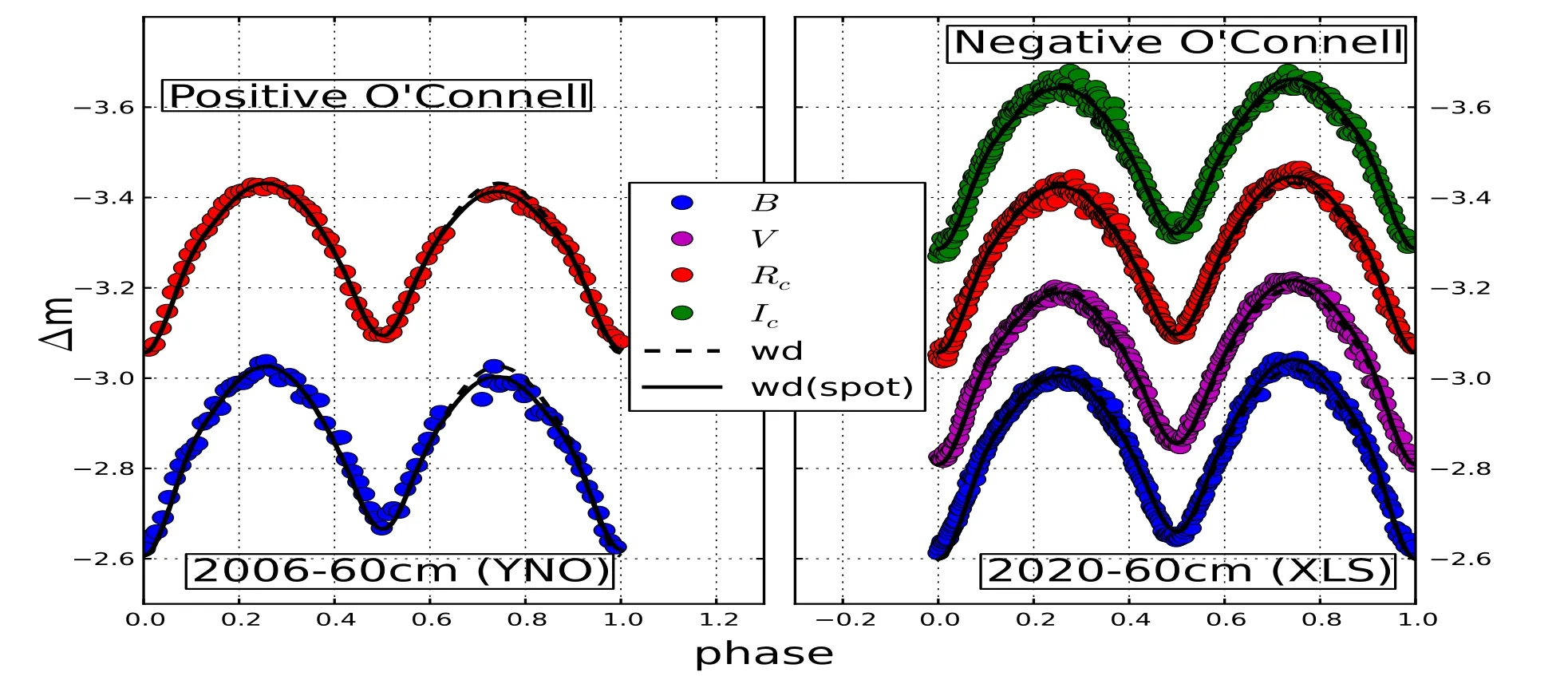
Figure 1.Left:BRc–band LCs observed in 2006,with 60 cm telescope administered by Yunnan Observatories.Right:BVRcIc-band observations in 2020,with the 60 cm telescope at Xinglong Station.The dotted lines refer to the theoretical LCs without a spot and the solid lines to the theoretical LCs with a spot.

Table 2Differential Magnitude Values at Two Maxima and Two Minima for UV Lyn in 2006 and 2020
2.2.Photometric solutions with the Wilson-Devinney program
By using the PHOEBE code based on the Wilson-Devinney program,version 2003,Kjurkchieva et al.(2020)carried out simultaneous solutions of both radial velocity and photometric LCs,the solutions of which determined that UV Lyn is a W-subtype contact binary withΔT=T1-T2=430 K,with a degree of contact off= 15.9%.Their mass ratio is 0.403,which is close to that of 0.371 presented by Lu&Rucinski(1999).They also found a cool equatorial spot.Lu et al.(2020)adjusted the starspot parameters to fit the LCs in 2014,1994,1982 and 1981,and found that UV Lyn is an eclipsing binary system with strong magnetic activity,and the longitude of cool starspots on the secondary component are located in the range 230°~40°.In order to investigate the magnetic activities and understand its evolutionary state,we intend to analyze the present multi-color LCs from 2006 and 2020.The photometric solutions were derived with the Wilson-Devinney program,version 2015(Wilson&Devinney 1971;Wilson 1979,1990;Van Hamme&Wilson 2007;Wilson 2008).
Synchronous rotation and zero eccentricity for UV Lyn are assumed.According to the LAMOST spectral type of G3V(Qian et al.2017,2020),the temperature of the primary(star eclipsed at primary light minimum)was fixed to beT1=5971 K,with an average ofT=5935 K in 2014 andT=6008 K in 2013.Based on the structure of W-subtype contact binary,we adopted the averaged value of 2.584 from two spectroscopic mass ratios of 1/0.371(Lu&Rucinski 1999)and 1/0.403(Kjurkchieva et al.2020)to derive parameters.Considering the convective atmospheres of the components,the same values of the gravity-darkening coef ficients and the bolometric albedos,i.e.,g1=g2=0.32(Lucy 1967)andA1=A2=0.5(Ruciński 1969),were taken in the model.
The asymmetries and variations of LCs are possibly due to magnetic activities on the surface of the component,so the spots were employed in our modeling.When testing the converged solutions,we added the cool spot into fitting the individual LCs.The corresponding photometric parameters are listed in Table 3.The dimensionless potentialΩ1(=Ω2)without a spot for over-contact con figuration is the same as the one with a spot,inferring the con figuration is not in fluenced by magnetic activity.From Figure 1,the dotted lines are the theoretical LCs without spots,and the solid lines show the calculated LCs with a dark spot on the primary component.It is obvious that the spot model with smaller residuals can fit LCs well.

Table 3Photometric Solutions for UV Lyn in 2006 and 2020
The solutions reveal that the fill-out factors in 2006 and 2020 are small,and the mass of the primary with higher temperature is less than that of the secondary,which con firms that UV Lyn is a W-type shallow contact binary.Besides,the location and temperature of the dark spot on the primary star(referred to by subscript 1)are variable,but the co-latitude of the stellar spot(referred to byφ)is 90°,which suggests the cool equatorial spot on the surface of the primary component has possibly migrated along the longitude.The con figurations of phases 0.25 and 0.75 were derived by the LC code,and are clearly displayed in Figure 2,which suggests the cool spot has possibly shifted from 2006 to 2020.It is necessary to obtain many more observations to con firm this activity.
3.Investigations on LCs from the Space Telescope
3.1.Observations
It is fortunate that we obtain high precision and continuous photometric data of UV Lyn observed by the space telescope TESS,which span nearly 28 days from January to March in 2020.The integration times are 120 s,the errors of the fluxes are less than 35 e-s-1and the corresponding magnitude errors are less than 0.0008 mag.To explore the distortions of these LCs in these continuous days,every cycle was investigated.The typical LCs along with their flux and times are displayed in Figure 3.The left panel displays positive O’Connell effect while the right manifests negative O’Connell effect.The difference between maxima light are up to 0.005 mag.
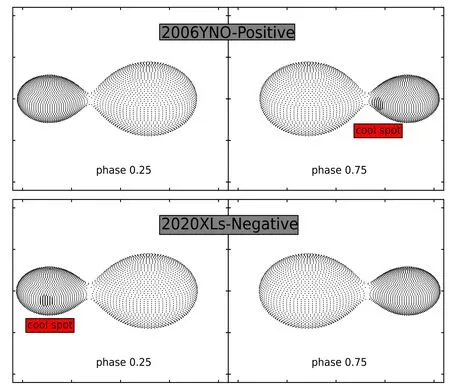
Figure 2.Geometric con figurations with a spot for UV Lyn in 2006 and 2020.
The extreme fluxes for every cycle were calculated and are displayed in Figure 4,where the red points are for Max I and Min I,and the black points correspond to Max II and Min II.It is clearly found that the maximum and minimum fluxes change along with time.In the upper panel,the red lines refer to the positive O’Connell effect in which Max I is brighter than Max II,while the green lines show the negative O’Connell effect.The variations of the O’Connell effect are first found in such a short time.Moreover,the flux difference between the minima are displayed with blue lines in the bottom panel of Figure 4,which con firms that the primary minima are nearly stable in every cycle,but the changes of the other minima are not obvious.The O’Connell effect and its variation provide us a good opportunity to explore the characteristics of magnetic activities,especially their continuity.
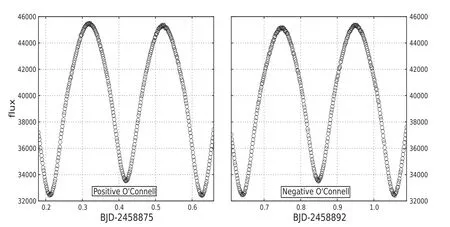
Figure 3.Part of the TESS observations show the positive and negative O’Connell effect.
3.2.Photometric Solutions with the Wilson-Devinney Program
The Barycentric Julian Dates(BJDs)were converted into phase by use of the period 0.414983 days from Equation(1)(Lu et al.2020)and the observed BJD minimum time,the flux into magnitudes withMag=- 2 .5 ×logFlux,and the typical LCs are shown in the left of Figure 3.The temperature of the primary and the mass ratio are the same as what was f ixed in Section 2.2.The Differential Correction code with spots was used to derive the photometric solutions.As shown in Table 4,the solution parameters suggest there is a cool spot on the equator of the primary component,consistent with the previous fitting analysis.In Section 2.2.,the cool spot possibly shifted,but due to lack of continuous observation,this is ambiguous.However,the variable O’Connell effects from TESS observations are powerful evidence to con firm the continuity of activities.In Figure 5,the red dotted lines refer to the theoretical LCs without a spot,and the solid lines refer to the theoretical LCs with a spot.Based on parameters of the dark spot in Table 4,it was found that the longitude changes in such short time,which demonstrates that the cool spot has possibly shifted along with time.The geometric con figurations of phases 0.25 and 0.75 were also derived and are displayed in Figure 6.The variation of the O’Connell effect is direct photometric evidence for the evolution of this dark spot.

Table 5The Parameters of the Equatorial Spot at Different Times for UV Lyn
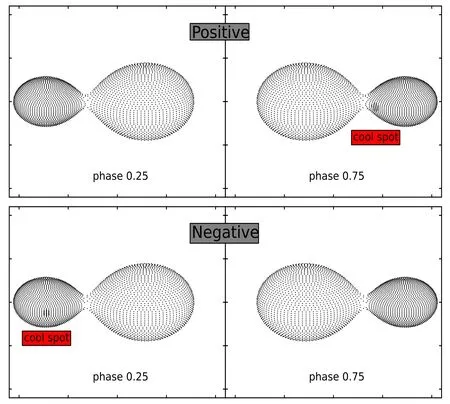
Figure 6.Geometric con figurations of UV Lyn with a spot for positive and negative O’Connell effect.
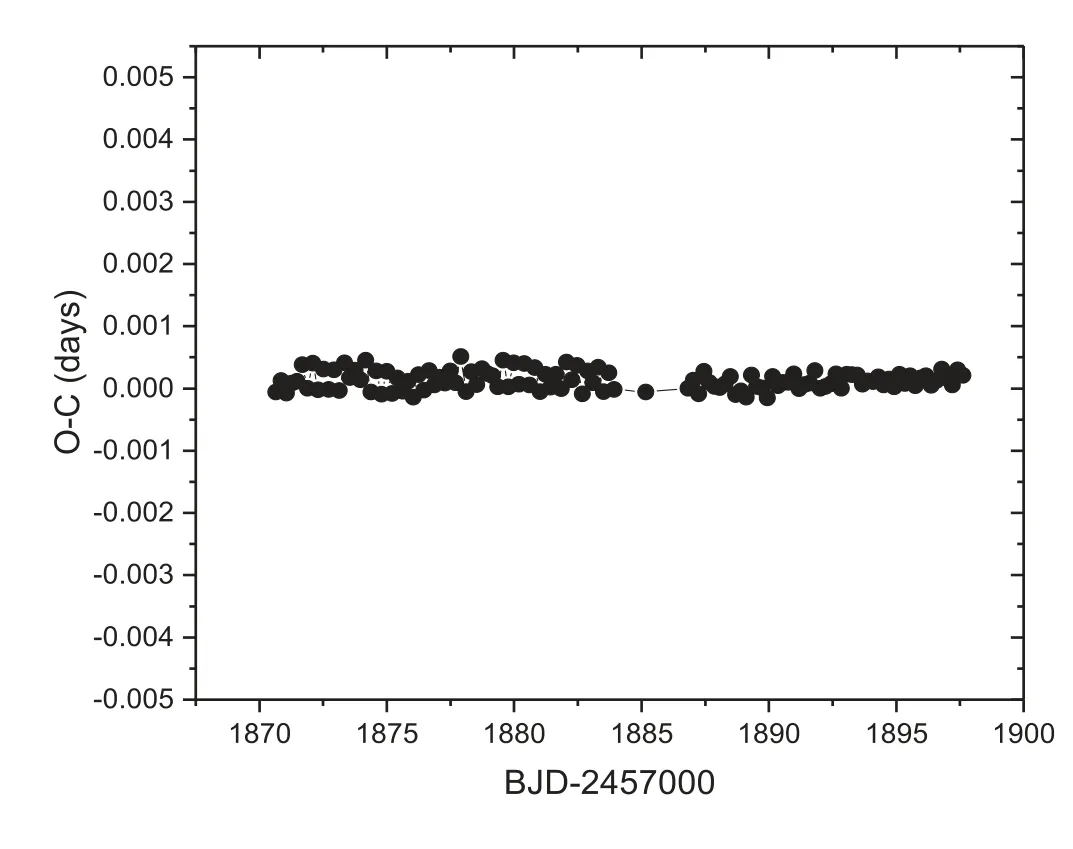
Figure 7.The O-C diagram for nearly 28 days in 2020.
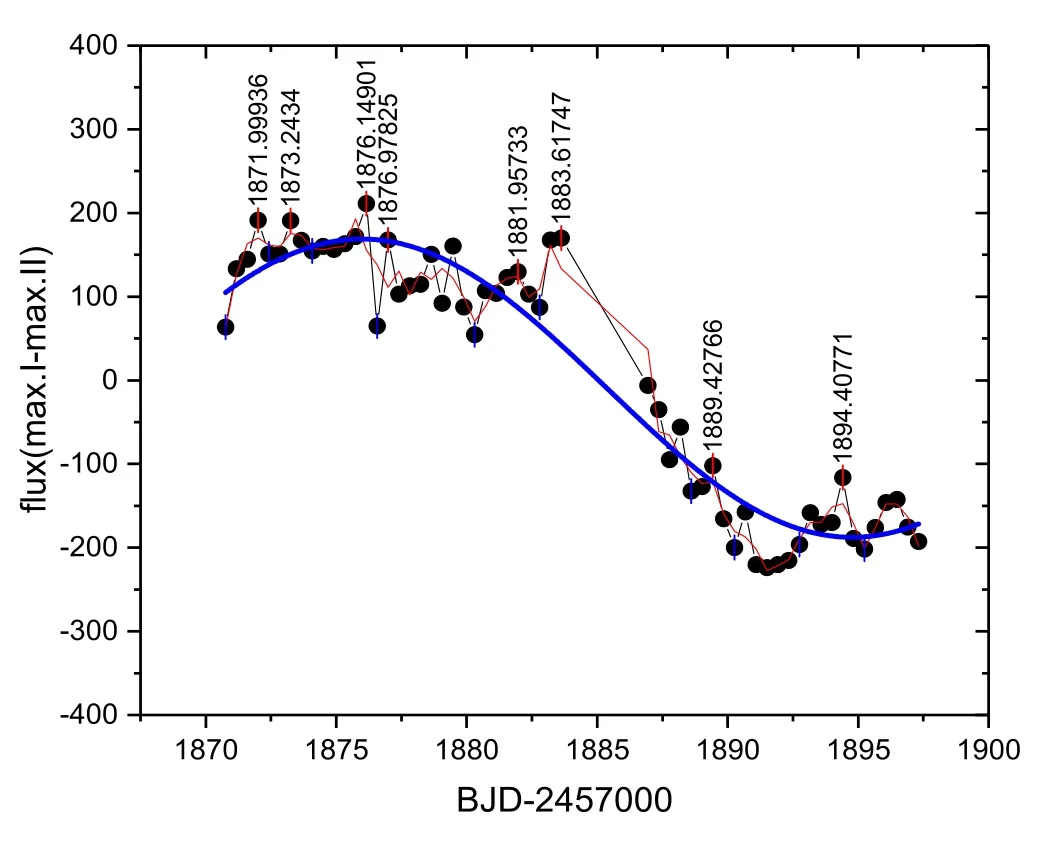
Figure 8.Continuous variation of the O’Connell effect.

Table 4Photometric Solutions of UV Lyn for TESS Observations
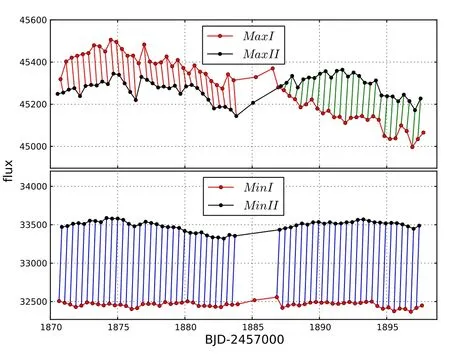
Figure 4.Flux for the minima and maxima in every cycle.In the upper panel,the red lines refer to the positive O’Connell effect in which Max I is brighter than Max II,and the green lines correspond to the negative O’Connell effect.In the bottom panel,the blue lines represent the difference between the minima.
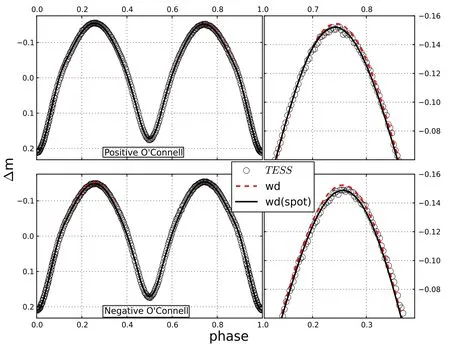
Figure 5.Typical positive and negative LCs from TESS in 2020.The dotted red lines refer to theoretical LCs without a spot,and the solid lines to theoretical LCs with a spot.
4.Variations of the Orbital Period in a Short Time
TheO-Canalysis is an important way to obtain the period evolutions of eclipsing binaries.The monotonic secular decrease or increase is explained by mass transfer between the components.The cyclic variation in theO-Ccurve indicates the presence of an additional body or a result of cyclic magnetic activity(Applegate 1989).The period of contact binary UV Lyn should be 0.41497872 days by Bossen(1973),who also collected a total of 70 visual and photographic times to calculateO-C.These results suggested a remarkable constancy of the period during the past 70 yr covered by observations.With 19 photoelectric times published,Markworth&Michaels(1982)corrected the period as 0.41498088 days.Zhang et al.(1995)used 27 photoelectric minima to derive a quadratic ephemeris,and it seemed that the period of UV Lyn is increasing distinctly but slowly.Vanko et al.(2001)made use of 140 times of minimum light to find the period increase,which could be interpreted by mass transfer from the less to more massive component.Based on 93 photoelectric and CCD times of minima,Kjurkchieva et al.(2020)improved the period to 0.414984584 days which is longer than the one by Markworth&Michaels(1982).Moreover,the residualO-Cdata show a sinusoidal trend with a period of 24 yr,which is possibly due to the presence of a third body.Lu et al.(2020)only use 143 photoelectric and CCD data to update the more accurate ephemeris,the orbital period of which was updated as 0.414983 days.
From the recent study of UV Lyn(Lu et al.2020),the orbital period is increasing.The secular variation needs much more times of light minimum for many years.However,based on continuous observations by TESS for nearly 28 days in 2020,we also calculated theO-Cin a short time and displayed the results in Figure 7.Compared with the secular increase by Lu et al.(2020),there is no apparent trend.
The LCs of many W UMa binaries exhibit the O’Connell effect,whose distortions and variations might be taken as an indicator of magnetic activity for these late-type contact binaries(Zhang et al.2014;He et al.2019;Pi et al.2019).So,we investigated variation of the O’Connell effect in 28 successive days in 2020,as displayed in Figure 7.It is shown that there is an incomplete periodic variation,which means UV Lyn is undergoing the magnetic cycle of 38 days.Comparing with theO-Ctrend in Figure 8,we can find that the period change is not related to the magnetic cycles.This result did not support that period changes can be interpreted in terms of magnetic cycles(Applegate 1989).
5.Conclusion
The G-type WUMa contact binary UV Lyn has been studied many times since 1955,the results of which suggest that its activity and evolution are still not completely understood.The cool equatorial spot on the component was published by Vanko et al.(2001),Kjurkchieva et al.(2020)and Lu et al.(2020).By using the Wilson-Devinney code,we also con firmed that UV Lyn is a W-type contact binary with a cool equatorial spot on the less massive component.The LCs from the ground-based telescope in 2006 and 2020 displayed the positive O’Connell and negative O’Connell effect respectively.The results in Table 3 con firm that the longitude and temperature of the dark spot are different.From the past studies of UV Lyn,the O’Connell effects are variable from 1973 to 2020,and only hint that the components were active in the past 47 yr.Because of the lack of continuous and unbroken time-series observations,the properties of this equatorial spot are unknown.From monitoring by the space telescope TESS from January to March in 2020,the continuous variations of O’Connell effect in every cycle were found for the first time.Based on the typical LCs with O’Connell effect,we derived the parameters of a dark spot,which display longitude changes in a short time.Considering the successive variability of the O’Connell effect,it is possible that one equatorial cool spot gradually shifts along with time.
In order to analyze the dark spot on the less massive component,these parameters of the starspot at different times are listed in Table 5.The O’Connell effects were positive when the longitude was small and negative when the longitude was large.These results suggest that the O’Connell effect is important evidence of magnetic activities for G-type late binaries.
Meanwhile,variations of the orbital period were investigated,and the increase in theO-Cdiagram(Lu et al.2020)was explained by mass-transfer from the less to more massive component.Depending on the successive observations,we also calculatedO-Cand tried to explore the trend in a short time.From Figure 7,there were no obvious variations,while the O’Connell effect as an indicator of the magnetic activity is possibly undergoing a periodic trend,as displayed in Figure 8,and a 38 days of magnetic activity cycle was derived.According to the result that the magnetic activity in fluences the period variation(Applegate 1989),although this magnetic cycle is shorter than some decades in some active binaries(Zhu&Qian 2009;Li et al.2014;He et al.2016;Zhu et al.2019),we could not find any relation between the magnetic activity cycle and the period variation.It is necessary to observe many active binaries to con firm the variation of magnetic activities in continuous time.
Starspot activity is a popular phenomenon among late-type stars in contact binaries,and produces the short-term variability in LC shape on a timescale of days to weeks.However,studies on the properties of the spot are less.Successive observations from TESS,Kepler,Gaia and so on gave us a good chance to further study G-type contact binaries such as UV Lyn.
Acknowledgments
The CCD photometric observations of UV Lyn were obtained with the 60 cm telescope administered by Yunnan Observatories and with the 60 cm telescope at Xinglong Station of National Astronomical Observatories.The continuous data in the paper were obtained by the TESS mission.This work is supported by the Joint Research Fund No.U1831109 in Astronomy under cooperative agreement between the National Natural Science Foundation of China(NSFC)and Chinese Academy of Sciences(CAS).
ORCID iDs
Jing-jing Wang https://orcid.org/0000-0002-9947-9263
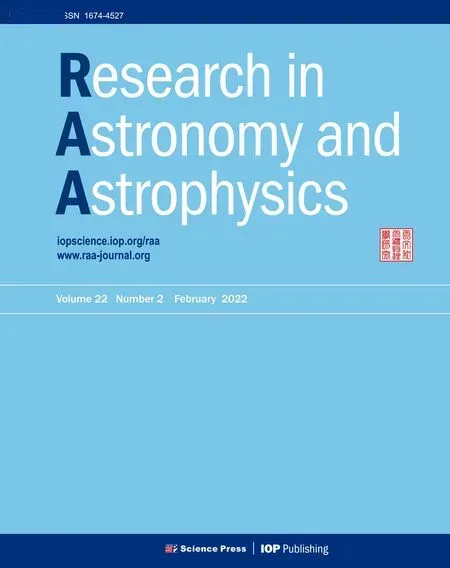 Research in Astronomy and Astrophysics2022年2期
Research in Astronomy and Astrophysics2022年2期
- Research in Astronomy and Astrophysics的其它文章
- Calibrating Photometric Redshift Measurements with the Multi-channel Imager(MCI)of the China Space Station Telescope(CSST)
- The“Bi-drifting”Subpulses of PSR J0815+0939 Observed with the Fivehundred-meter Aperture Spherical Radio Telescope
- Application of Random Forest Regressions on Stellar Parameters of A-type Stars and Feature Extraction*
- Detection of Gamma-Rays from the Protostellar Jet in the HH 80–81 System
- Radio Frequency Interference Mitigation and Statistics in the Spectral Observations of FAST
- Systematic Errors Induced by the Elliptical Power-law model in Galaxy–Galaxy Strong Lens Modeling
